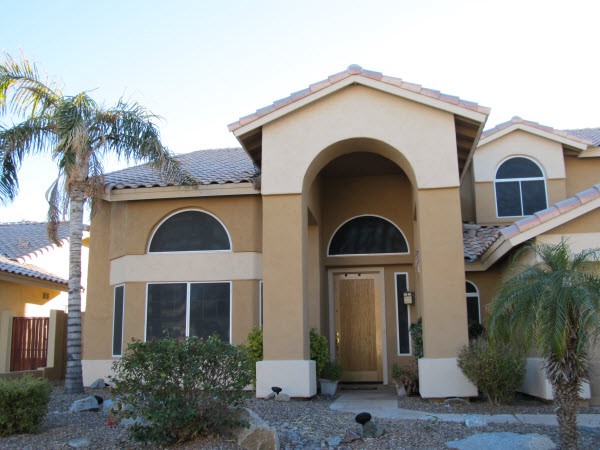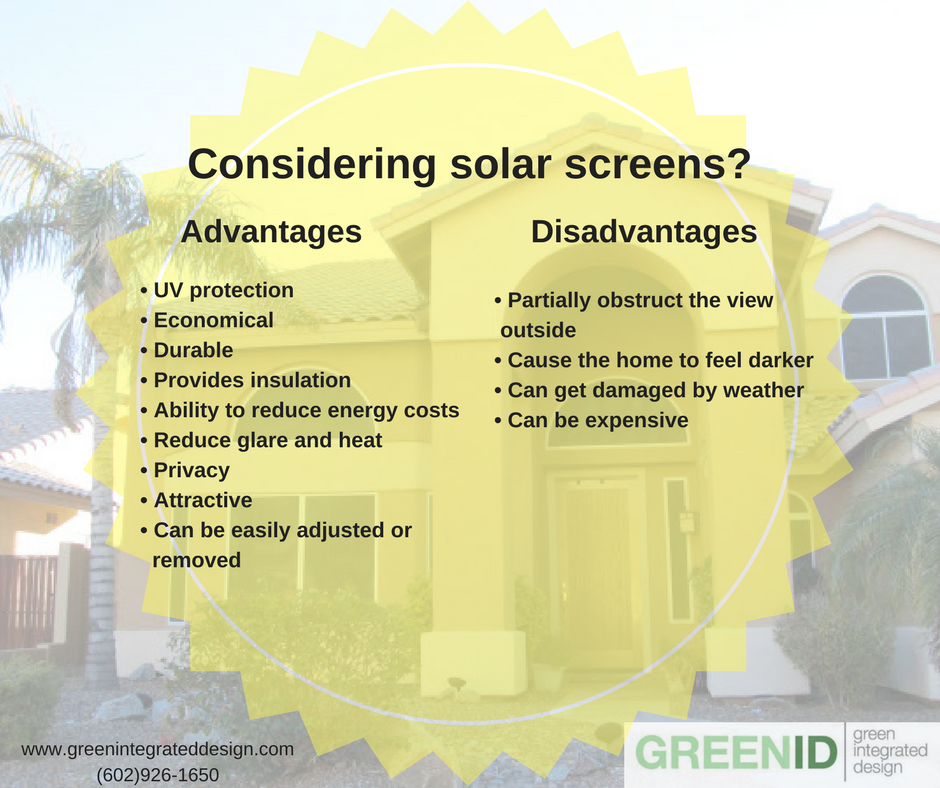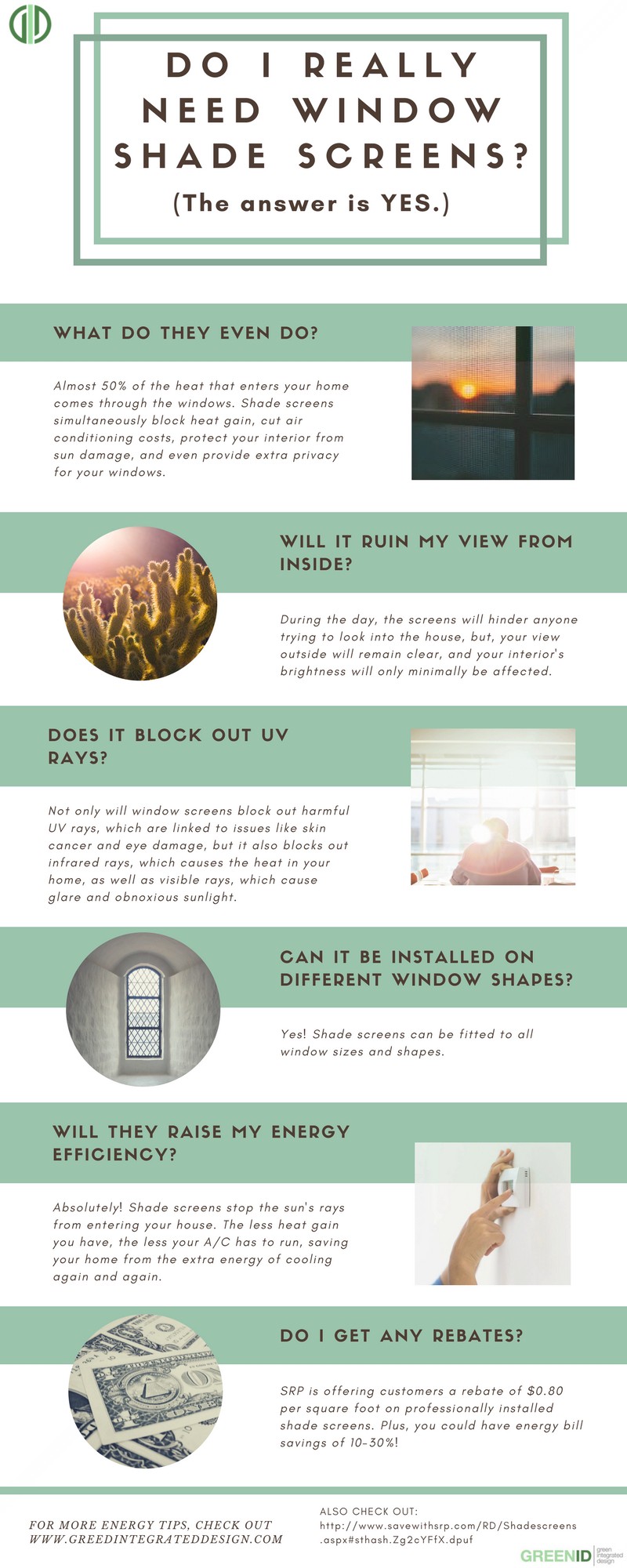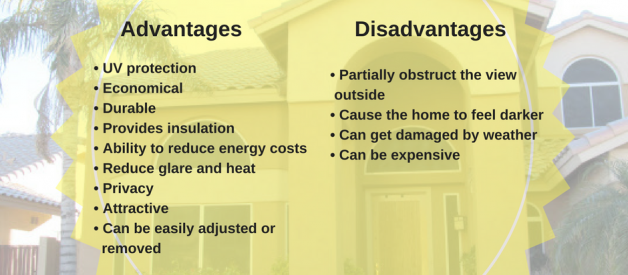Solar screens are a good way to reduce heat and light during the summer. They can either be a roller shade or fixed panels installed on a window, patio, balcony, or porch.
 Solar screens as seen on an Arizona home
Solar screens as seen on an Arizona home
Solar screens are made of polyester or fiberglass coated and finished with different materials, which makes them durable and stable. Screens come in many colors and can be matched nicely with the exterior color scheme of the house.
Solar screens are one of the most inexpensive, temporary solutions to protect from the sun, heat, and glare, and to get some privacy.
Advantages of solar screens
UV protection
Economical
Durable
Provides lots of insulation against outdoor temperatures
Ability to reduce energy costs
Reduce glare and heat
Privacy
Attractive aesthetic
Can be easily adjusted to your preference or removed during the winter months
Exterior screens have much better shading benefits than do interior screens.
Disadvantages of solar screens
Partially obstruct the view outside
Cause the home to feel darker (less natural light is let in)
If the screens are not fitted securely, they can get damaged in a storm or other harsh weather conditions.
Can be expensive, depending on the type of screen and the installation

Where to best use solar screens in the home
In order to make the most of solar screens in the home, it is important to use them in locations most suited to this type of window treatment. Any room that receives lots of sunlight, for example, will be a prime candidate for solar shades. Many homeowners choose to put shades on south-facing windows because these will receive the most morning light and the most sunshine throughout the course of the day. Solar screens also create privacy when used on bathroom windows, and they can help to grant privacy in large sitting or living rooms without sacrificing views of the outside. For completely unobstructed views, however, using shades may not always be the best choice. Solar screens can be used on almost any window type as well as on glass patio doors, French doors, or sliding doors.
Choosing an openness level for solar screens
One thing that many homeowners do not realize about solar screens is that they come in varying ranges of light filtering and privacy. Since these shades are made from a mesh, the size of the holes in the mesh will dictate what is called the openness factor, or amount of natural light let in. Typically, the range of openness factors starts at 1 percent and goes up to 12 percent. At 1 percent openness, a screen will look almost black from the interior. It grants complete privacy and does a fantastic job of keeping the home cool, but it is the most detrimental to the view. Moving up to 3 percent reduces the dark color of the solar screen, but still provides almost complete privacy and sun protection. Shades with a 5 percent openness are among the most popular as they still offer relatively clear views without direct sunlight, but 10 percent is also a popular choice. Homeowners looking to buy their solar screens from a retail company rather than a custom-designer might find that most shades are available in 5 or 10 percent openness.
Factors that can increase the cost of a solar screen
There are a variety of factors that can increase or decrease the cost of solar screens. Size is the biggest influence on price, and large shades designed for doors will be much more expensive than the standard sized shades made for most windows. For the most part, the openness factor of screens does not factor into the price. The most expensive solar shades will be those that are custom-made to fit a particular window or door. These shades will have to be measured in advance and then manufactured by hand, which drives the price up substantially.

What homeowners should know about installation
With some DIY experience and the right tools, many homeowners can install their own solar screens. However, leaving it to the professionals ensures a sleeker fit and better insulation. One thing to think about before installing or even purchasing shades is whether the will be mounted inside of the recess of the window or above the frame itself. Whenever possible, installing shades inside of the window recess is a good idea that looks fantastic and blocks out the most sunlight.
For more information about solar screens, or to get started with installing them, call Green ID at (602)926?1650 today!


